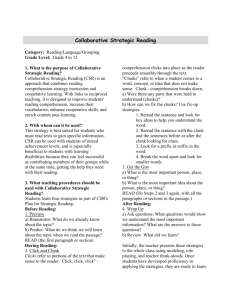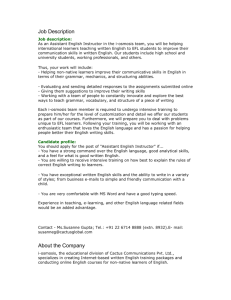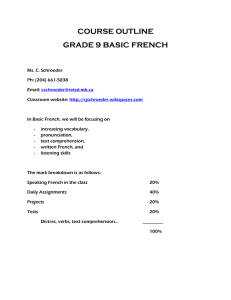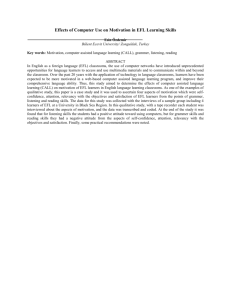Collaborative Strategic Reading to Enhance Learners' Reading Comprehension in
advertisement
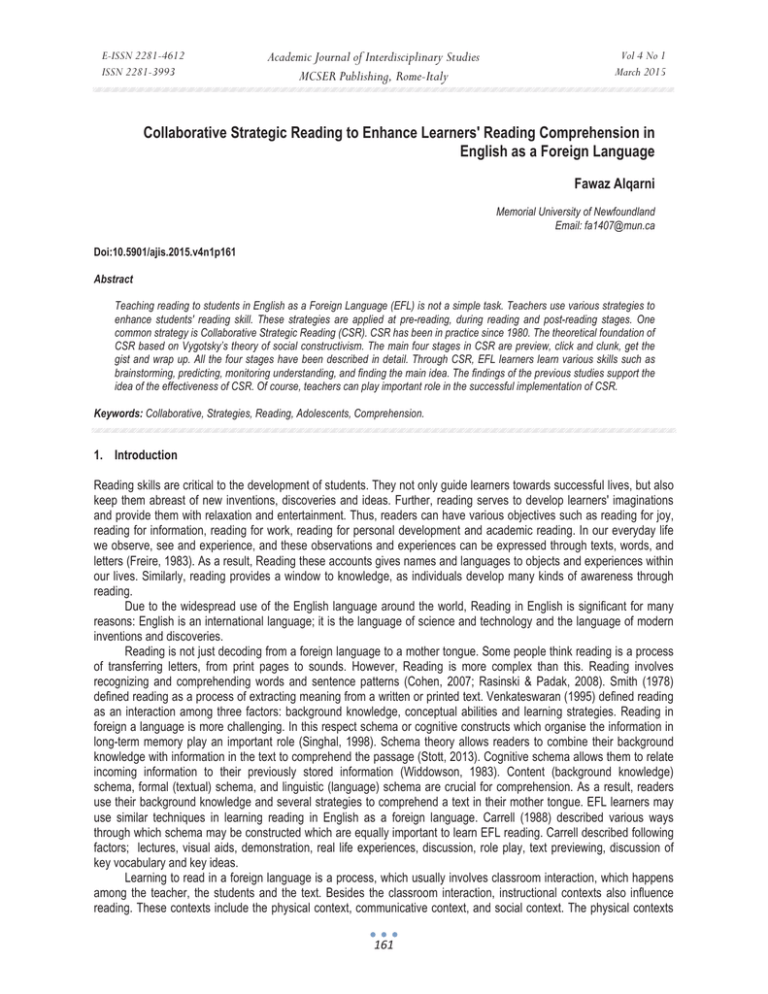
E-ISSN 2281-4612 ISSN 2281-3993 Academic Journal of Interdisciplinary Studies MCSER Publishing, Rome-Italy Vol 4 No 1 March 2015 Collaborative Strategic Reading to Enhance Learners' Reading Comprehension in English as a Foreign Language Fawaz Alqarni Memorial University of Newfoundland Email: fa1407@mun.ca Doi:10.5901/ajis.2015.v4n1p161 Abstract Teaching reading to students in English as a Foreign Language (EFL) is not a simple task. Teachers use various strategies to enhance students' reading skill. These strategies are applied at pre-reading, during reading and post-reading stages. One common strategy is Collaborative Strategic Reading (CSR). CSR has been in practice since 1980. The theoretical foundation of CSR based on Vygotsky’s theory of social constructivism. The main four stages in CSR are preview, click and clunk, get the gist and wrap up. All the four stages have been described in detail. Through CSR, EFL learners learn various skills such as brainstorming, predicting, monitoring understanding, and finding the main idea. The findings of the previous studies support the idea of the effectiveness of CSR. Of course, teachers can play important role in the successful implementation of CSR. Keywords: Collaborative, Strategies, Reading, Adolescents, Comprehension. 1. Introduction Reading skills are critical to the development of students. They not only guide learners towards successful lives, but also keep them abreast of new inventions, discoveries and ideas. Further, reading serves to develop learners' imaginations and provide them with relaxation and entertainment. Thus, readers can have various objectives such as reading for joy, reading for information, reading for work, reading for personal development and academic reading. In our everyday life we observe, see and experience, and these observations and experiences can be expressed through texts, words, and letters (Freire, 1983). As a result, Reading these accounts gives names and languages to objects and experiences within our lives. Similarly, reading provides a window to knowledge, as individuals develop many kinds of awareness through reading. Due to the widespread use of the English language around the world, Reading in English is significant for many reasons: English is an international language; it is the language of science and technology and the language of modern inventions and discoveries. Reading is not just decoding from a foreign language to a mother tongue. Some people think reading is a process of transferring letters, from print pages to sounds. However, Reading is more complex than this. Reading involves recognizing and comprehending words and sentence patterns (Cohen, 2007; Rasinski & Padak, 2008). Smith (1978) defined reading as a process of extracting meaning from a written or printed text. Venkateswaran (1995) defined reading as an interaction among three factors: background knowledge, conceptual abilities and learning strategies. Reading in foreign a language is more challenging. In this respect schema or cognitive constructs which organise the information in long-term memory play an important role (Singhal, 1998). Schema theory allows readers to combine their background knowledge with information in the text to comprehend the passage (Stott, 2013). Cognitive schema allows them to relate incoming information to their previously stored information (Widdowson, 1983). Content (background knowledge) schema, formal (textual) schema, and linguistic (language) schema are crucial for comprehension. As a result, readers use their background knowledge and several strategies to comprehend a text in their mother tongue. EFL learners may use similar techniques in learning reading in English as a foreign language. Carrell (1988) described various ways through which schema may be constructed which are equally important to learn EFL reading. Carrell described following factors; lectures, visual aids, demonstration, real life experiences, discussion, role play, text previewing, discussion of key vocabulary and key ideas. Learning to read in a foreign language is a process, which usually involves classroom interaction, which happens among the teacher, the students and the text. Besides the classroom interaction, instructional contexts also influence reading. These contexts include the physical context, communicative context, and social context. The physical contexts 161 E-ISSN 2281-4612 ISSN 2281-3993 Academic Journal of Interdisciplinary Studies MCSER Publishing, Rome-Italy Vol 4 No 1 March 2015 such as a classroom, a lab, resource room, instructional material, chairs and tables greatly influence the learning process. Similarly, the communicative context such as verbal, written, symbolic, and body language and social context also have important impacts on learning. Smith (1978) places emphasis on good blending of these contexts for an effective learning process. Learning to read is influenced by the interaction of the student, the teacher and the text. In this sense, students as readers interact with the text, with other readers as well as with teachers. Readers interpret and critically evaluate the text. They share thoughts, feelings and ideas with the author of the text. They also exchange and share the ideas with other readers and with their teachers (Smith, 1978). Some linguists recognize reading and listening as passive or receptive skills and writing and speaking as active or productive skills. Smith (1978) does not agree with their point of view. He identifies reading as an active skill. He presents the evidence of a reader's active involvement in making sense out of the printed text. Readers actively interact with text to comprehend the meaning of the text. Getting the main ideas, commenting on the text and responding to the comprehension questions are some forms of readers' active involvement in reading. What learners bring from reading, viewing, and listening helps them in understand the received communication. On the other hand, what learners bring from two other skills such, as speaking writing, helps them to convey their thoughts to others. The process of reading in a foreign language has some similarities with the reading in the first language such as background knowledge, knowledge of content, formal, and linguistic schema (Singhal, 1998). However, once a person has learned to read effectively, which leads to comprehension, then he/she can use this reading ability to learn more about the language. On the other hand, it becomes a frustrating experience for a foreign language learner if she/he has not learned to read strategically. Therefore, it is the teacher's responsibility to teach students how to read strategically and effectively. The process of reading happens through visual information and non-visual information and this is similar for learning reading in a foreign language. Visual information is taken from the printed text, while non-visual information exists in a reader's brain from his/her previous experiences or background. A reader, first of all, uses eyes to take a photo of the printed text. Then, he/she sends the perceived visual information to his/her brains' short memory. The memories of a brain perform many jobs, such as determining what type of information to retain, how long to retain it and when to retrieve it. When a piece of information is sent to the brain, the brain matches the visual information with non-visual information. If it is matched, then it is sent to the long-term memory of the brain. Otherwise, it is sent to the short-term memory of the brain. The information in the long-term memory of the brain is easier to understand. The reason that children have difficulties in learning to read is because they have less non-visual information. On the other hand, if an experienced EFL reader has less difficulty in reading it is because he/she has past experiences in the form of non-visual information. Accordingly, Smith (1979) made three suggestions: fast, selective and non-visual information focused reading for a successful reading process. Fast reading will help the reader to avoid the overload of short-term brain memory. The non-visual information focused reading will facilitate comprehension. Improving students' reading skill in English as a foreign language is a perennial challenge for teachers. Many research studies show that learners do not fully understand complex texts (Biancarosa & Snow, 2004). Williams (1998) clearly describes that reading comprehension is not an easy task for many readers. As a result, they are unable to benefit from reading for pleasure and other developmental opportunities. More than 8 million middle and high school students are struggling readers (Joseph & Schisler, 2009). RubinsteinÁvila (2003/2004) presents three categories of struggling readers: 1. Students expend so much energy decoding printed words that they fail to derive any meaning. 2. Students can understand what is being read to them in spite of their limited word recognition skills. 3. Students are able to decode sentences but fail to activate their schema and thus do not interact with the text to “make meaning, expand, or provide a critique or even a summary” (p. 290). To enhance students' reading comprehension in EFL, teachers use many strategies such as cooperative and collaborative learning. Gauthier (2001) recommends cooperative learning, discussion and questioning (Coop-Dis-Q) strategies to enhance the reading skills of learners. Some others recommend collaborative strategic reading (CSR), Peer Assisted Learning Strategies (PALS) and Modified Reciprocal Teaching (Klinger et al, 2012; Klinger & Vaughn, 1998). All the strategies were developed for general struggling readers but these are also applicable to EFL learners. The main purpose of these strategies is to create a cooperative learning environment where students monitor their reading comprehension. Johnson and Holubec (1984) defined cooperative learning as students helping each other to maximize their learning. Many research studies support the use of cognitive and metacognitive strategies to enhance reading 162 E-ISSN 2281-4612 ISSN 2281-3993 Academic Journal of Interdisciplinary Studies MCSER Publishing, Rome-Italy Vol 4 No 1 March 2015 comprehension of learners (Montague, & Tanner, 1987). These strategies are applied at pre-reading, reading and post reading stages. Each strategy has its own benefits at each stage. Smith (1976) asserts that it is a teacher's prime responsibility to choose appropriate strategies for reading to engage learners independently, because students learn to read by reading more. There are some common strategies that have been used by teachers for several years that mentioned earlier to enhance EFL learners' reading comprehension. However, I will focus my paper on CSR. Wilawan (2012) argues that EFL students' support in knowledge in understanding the basic text is necessary to make them competent. 2. Collaborative Strategic Reading Since 1980, CSR has been used in teaching and learning due to its benefits such as enhancing motivation, critical thinking skills, collaborative learning, a positive attitude, group work and social skills (Brown, 2008; Salomon & Globerson, 1989; Lin et al., 2011). Vygotsky's theory that knowledge is socially constructed provides a foundation for CSR. Children learn when they interact with people from their environment and in cooperation with their peers (Vygotsky, 1978, p.104). Vygotsky argued that a child has two different levels of development. The first level is the actual level, where a child can solve problems by him/herself. The second level is the potential level, where a child can solve problems with the assistance of others (Seng, 2007). The difference between both levels is called the zone of proximal development (ZPD). The second level can be achieved under adult guidance or through collaborative learning (Vygotsky, 1978, p.86). In the beginning, students do not have much understanding of all the four stages of CSR. During the first week of the class, a teacher explains CSR stages to students. The teacher also train the students by practice such as for the click and clunk stage, a teacher gives his/her students an easy paragraph. The student read the paragraph in short time in two to three minutes to understand the entire paragraph in order to predict and to activate their background knowledge. If the students understand the whole context, then it is click (I get it). If the students do not understand the context, then their teacher tells them to underline the difficult words it is called clunk (I do not get it). After that, their teacher encourages peers to explain the meanings of the words. If peers also do not know the meanings, then their teacher explains the meanings to them. Same strategy is used for all the four stages to train students. As a result, the students can use these strategies effectively by themselves. Once students are proficient in CSR, they are assigned roles as a leader, as a clunk expert, as an announcer, as an encourager, as a reporter and a timekeeper. The students are divided in groups of 4, 5 or 6. The leader tells the group what strategy to use and when. The clunk expert uses the clunk cards to remind the group of the steps to follow. The announcer makes sure that everyone participates in the activity. The encourager encourages and praises all group members. The reporter reports the main ideas to the class. The timekeeper sets the time for each activity. I am also going to explain these strategies in coming paragraphs. Klinger and Vaughn (1998) illuminate the four stages: preview, click and clunk, get the gist and wrap up. In the beginning, all the four strategies are taught to students. When they become proficient, they are divided into groups to practice the strategies. At the first stage, students preview the passage. This preview helps the students to learn the most about the passage, to activate their background knowledge about the topic and to make predictions. During preview, students notice headings, underlined worlds, pictures, tables and graphs. For example Abidin & Riswanto (2012) ask following questions to students whether they have ever been to the movies. Do you learn who is going to be in the movie? Do you learn during what historical period the movie will take place? Do you learn whether or not you might like the movie? Do you have questions about what more you would like to know about the movie? The second stage is called the click and clunk stage. At this stage, students click and clunk while reading. Clicks refer to understandable parts of reading and clunks refer to complicated concepts, ideas and words. The main purpose of the click and clunk stage is to encourage students to pay attention to reading for understanding. At the next stage, students learn to get the gist by identifying the main idea in the passage. They rephrase the main idea in their own words to make sure that they understand the concept. Teacher asks the students to tell in their own words about the most important places, persons and events they just read. At the wrap up stage, students formulate questions and answers based on the key ideas they have just learned. The main goals of the wrap up stage are to improve students' knowledge, understanding and memory of the paragraph. The students generate their questions with question starters such as who, what, why, when, where, and how. In the same way, these strategies can be used with EFL learners. Klinger and Vaughn also describe the importance of group roles. They state that, in the beginning, students learn 163 E-ISSN 2281-4612 ISSN 2281-3993 Academic Journal of Interdisciplinary Studies MCSER Publishing, Rome-Italy Vol 4 No 1 March 2015 through teacher led activities. Later, students are ready to perform their own roles in a cooperative learning environment. Students can perform more than one role such as group leader, clunk expert, announcer, encourager, reporter and timekeeper. All these roles enhance students’ reading skills through collaborative learning. Klinger, and Vaughn (1999) state that a teacher's role changes when students start working in groups. The teacher just monitors the students and provides them necessary assistance. Students cooperate with each other. They teach and learn in groups from peers. Klinger, Vaughn, et al., (2004) illustrate the benefits of CSR. They describe that CSR helps students learn some specific strategies such as learning in a cooperative environment, brainstorming and predicting (preview), monitoring understanding (click and clunk), finding the main idea (get the gist), generating questions and reviewing key ideas (wrap up). Primarily, Collaborative Strategic Reading (CSR) was designed to facilitate reading comprehension for students with reading issues (Klinger, Vaughn et al., 2001). Klinger, Vaughn, et al., (2004) argue that CSR also addresses the following issues: 1. how to adequately include students with disabilities and English language learners (ELL) in text related learning. 2. how to teach text comprehension strategies that facilitate students' learning from expository text. 3. how to provide opportunities for students with learning disabilities to interact effectively with peers. 3. The Effectiveness of CSR Klinger, Vaughn, et al., (2004) carried out a quantitative research study with five intervention and five control teachers from five schools with their students. The findings indicated that students in CSR classes remarkably improved their reading comprehension. Two years later, Kim et al., (2006) conducted an experimental study with students from grades six to eight. A computer based CSR version was used for the intervention group. The findings indicated that students with the CSR group outperformed students in the comparison group. In another study with English as a foreign language (EFL) learners, Zoghi, Mustapha, Maasum, and Mohd (2010) found that EFL learners have positive attitudes towards collaborative strategies of reading. Annamma et al., (2011) interviewed 17 middle school teachers. The authors found that CSR is beneficial for all learners, especially for English language learners, struggling learners and marginalised learners or for learners who are at risk of failure in middle school. All the teachers were very satisfied with CSR and they wanted to continue to apply CSR in the future. In one of their recent experimental studies, Vaughn et al., (2011) examined the effects of collaborative strategic reading and metacognitive learning of students in grade seven and eight English language arts classes. Students from 61 classes participated in this study. The authors found a significant difference in favour of treatment groups. Fan (2010) undertook a quantitative research study with 110 EFL learners to evaluate the effectiveness of collaborative strategic reading at university in Taiwan. The author found that CSR had a positive effect on EFL learners' reading comprehension, especially in terms of comprehension questions of getting the main idea and exploring the supporting details. Recently, Karabuga & Kaya (2013) carried out a quantitative research study to examine the effectiveness of CSR on EFL students' reading comprehension. EFL learners from 40 prep classes at university level participated in this research study. The study also indicates that CSR has affected positively students learning in reading comprehension. In these days, the main challenge for teachers is how to successfully use CSR to enhance reading skills with information communication technologies. Warschauer (2008) conducted a multi case research study in the US. Data were collected through observations, interviews, surveys and document reviews. All the participants had access to laptop computers throughout the school day. The findings showed that laptop computers had not improved their reading skills. Lin, Chan, and Hsiao (2011) conducted an explanatory sequential design research study with 91 eighth grade EFL students in Taiwan. Their main intention was to explore perceptions of students of learning vocabulary collaboratively through computers. First quantitative data were collected through empirical design. The findings indicated that students learning vocabulary collaboratively with computers did not outperform students learning vocabulary without computers. Then the qualitative data were collected through interviews. The findings indicated that more than 70 % of the participants preferred a collaborative learning environment using computers. 4. Conclusion Reading is a complex process for some learners in learning their first language. This process becomes more complicated when they learn a foreign language. Prior knowledge, past experiences and learners' backgrounds assist learners in comprehending new information in learning reading in their mother tongue as well as in EFL. The percentage of 164 E-ISSN 2281-4612 ISSN 2281-3993 Academic Journal of Interdisciplinary Studies MCSER Publishing, Rome-Italy Vol 4 No 1 March 2015 struggling readers in foreign language learning or in first language learning is not low. To overcome the issue, teachers use many strategies to enhance students' comprehension skill. CSR is most commonly used to enhance reading skills of various types of students such as English language learners, learners with disabilities, struggling learners and marginalised learners. CSR has four stages: preview, click and clunk, get the gist and wrap up. Each stage has its own benefits such as brainstorming, monitoring understanding, finding the main concept, generating questions and reviewing key ideas. Of course, CSR presents some challenges such as that research studies have mixed findings on collaborative strategic reading with technology. However, many research studies have shown the effectiveness of CSR for reading comprehension. Teachers should choose appropriate strategies to teach reading to students. 5. Acknowledgement I am grateful to the Ministry of Education and the Ministry of Higher Education, in the Kingdom of Saudi Arabia, and Saudi Cultural Bureau in Canada for their continuous support in my PhD program and the research project. References Abidin, M. J. Z., & Riswanto, R. (2012). Collaborative Strategic Reading (CSR) within cognitive and metacognitive strategies perspectives. European Journal of Business and Management, 4(1), 61-69. Annamma, S., Eppolito, A., Klingner, J., Boele, A., Boardman, A., & Stillman-Spisak, S. J. (2011). Collaborative Strategic Reading: Fostering Success for All. Voices from the Middle, 19(2), 27-32. Biancarosa, G., & Snow, C. E. (2004). Reading next—A vision for action and research in middle and high school literacy: A report from Carnegie Corporation of New York. Washington, DC: Alliance for Excellent Education. Brown, F. A. (2008). Collaborative learning in the EAP classroom: Students’ perception. ESP World, 17, 1-18. Carrell,P.L., Devine,J. and Eskey,D.E. (eds) (1988) Interactive Approaches to Second Language Reading. Cambridge: CUP. Cohen, J. (2007). A Case Study of a High School EnglishǦLanguage Learner and His Reading. Journal of Adolescent & Adult Literacy, 51(2), 164-175. Fan, Y. C. (2010). The Effect of Comprehension Strategy Instruction on EFL Learners’ Reading Comprehension. Asian Social Science, 6(8), P19. Freire, P. (1983). The importance of the act of reading. Journal of Education, 165(1), 5-11. Gauthier, L. R. (2001). Coop-Dis-Q A Reading Comprehension Strategy. Intervention in school and clinic, 36(4), 217-220. Johnson, D. W., Johnson, R. T., Holubec, E. J., & Roy, P. (1984). Circles of learning: Cooperation in the classroom. Alexandria, VA: Association for supervision and curriculum development. Karabuga, F., & Kaya, E. S. (2013). Collaborative Strategic Reading Practice with Adult EFL Learners: A Collaborative and Reflective Approach to Reading. Procedia-Social and Behavioral Sciences, 106, 621-630. Joseph, L. M., & Schisler, R. (2009). Should adolescents go back to the basics? A review of teaching word reading skills to middle and high school students. Remedial and Special Education, 30(3), 131-147. Kim, A.-H., Vaughn, S., Klingner, J. K., Woodruff, A. L., Klein, C., & Kouzekanani, K. (2006). Improving the reading comprehension of middle school students with disabilities through computer-Assisted collaborative strategic reading (CACSR). Remedial and Special Education, 27, 235–248. Klingner, J. K., Boardman, A. G., Eppolito, A. M., & Schonewise, E. A. (2012). Supporting Adolescent English Language Learners' Reading in the Content Areas. Learning Disabilities: A Contemporary Journal, 10(1), 35-64. Klingner, J. K., Vaughn, S., Arguelles, M. E., Hughes, M. T., & Leftwich, S. A. (2004). Collaborative Strategic Reading “Real-World” Lessons From Classroom Teachers. Remedial and Special Education, 25(5), 291-302. Klingner, J., Vaughn, S., Dimino, J., Schumm, J., & Bryant, D. (2001). From clunk to click: Collaborative Strategic Reading. Longmont, CO: Sopris West. Klingner, J. K., & Vaughn, S. (1999). Promoting reading comprehension, content learning, and English acquisition though Collaborative Strategic Reading (CSR). The Reading Teacher, 52(7), 738-747. Klingner, J. K., & Vaughn, S. (1998). Collaborative strategic reading. Teaching exceptional children, 33. KOW, K. Y. C., & Amir, B (2008). Enhancing reading comprehension via instruction of a metacognitive strategy: A case study of Iranian EFL learners. Applied Linguistics. Lin, C. C., Chan, H. J., & Hsiao, H. S. (2011). EFL students’ perceptions of learning vocabulary in a computersupported collaborative environment. TOJET: The Turkish Online Journal of Educational Technology, 10(2), 91-99. Montague, M., & Tanner, M. L. (1987). Reading strategy groups for content area instruction. Journal of Reading, 30(8), 716-723. Rasinski, T. V., & Padak, N. (2008). From phonics to fluency: Effective teaching of decoding and reading fluency in the elementary school. Allyn & Bacon. Robinson, Francis. Effective Study. New York, N.Y.: Harper and Brothers, 1946. Rubinstein-Ávila, E. (2003/2004). Conversing with Miguel: An adolescent English Language Learner struggling with later literacy development. Journal of Adolescent & Adult Literacy, 47, 290–301. 165 E-ISSN 2281-4612 ISSN 2281-3993 Academic Journal of Interdisciplinary Studies MCSER Publishing, Rome-Italy Vol 4 No 1 March 2015 Salomon, G., & Globerson, T. (1989). When teams do not function the way they ought to. International Journal of Educational Research, 13, 89-99. Seng, G. H. (2007). The effects of think-aloud in a collaborative environment to improve comprehension of L2 texts. Reading, 7(2). Singhal, M. (1998). A comparison of L1 and L2 reading: Cultural differences and schema. The internet TESL journal, 4(10). Smith, F. (1976). Learning to read by reading. Language Arts, 53(3), 297-322. Stott, N. (2001). Helping ESL students become better readers: Schema theory applications and limitations. The Internet TESL Journal, 7(11), 1-10. Vaughn, S., Klingner, J. K., Swanson, E. A., Boardman, A. G., Roberts, G., Mohammed, S. S., & Stillman-Spisak, S. J. (2011). Efficacy of Collaborative Strategic Reading With Middle School Students*. American educational research journal, 48(4), 938-964. Venkateswaran, S. (1995) Principles of Teaching English. Madras: Vikas Publishing House. Pvt. Ltd. Vygotsky, L.S. (1978). Mind in society: The development of higher psychological processes. Cambridge, MA: Harvard University Press. Warschauer, M. (2008). Laptops and literacy: A multi-site case study. Pedagogies: An International Journal, 3(1), 52-67. Widdowson, H. G. (1983). Learning purpose and language use (pp. 54-54). Oxford: Oxford University Press. Wilawan, S. (2012). Fostering Main Idea Comprehension among EFL Learners through Cognitive and Metacognitive Strategies. Williams, J. P. (1998). Improving comprehension of disabled readers. Annals of Dyslexia, 48, 213–238. Zoghi, M., Mustapha, R., Maasum, T., & Mohd, N. R. (2010). Collaborative Strategic Reading with University EFL Learners. Journal of College Reading and Learning, 41(1), 67-94. 166
